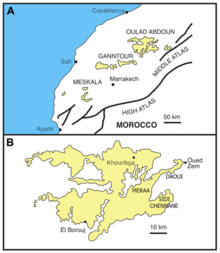Ouled Abdoun Basin
Coordinates: 32°54′N 6°57′W / 32.900°N 6.950°W

The Oulad Abdoun Basin (also known as the Ouled Abdoun Basin or Khouribga Basin) is a phosphate sedimentary basin located in Morocco, near the city of Khouribga. It is the largest in Morocco, comprising 44% of Morocco's phosphate reserves, and at least 26.8 billion tons of phosphate.[1][2] It is also known as an important site for vertebrate fossils, with deposits ranging from the Late Cretaceous (Cenomanian-Turonian) to the Eocene epoch (Ypresian), a period of about 25 million years.[3]
Geography
The Oulad Abdoun is located west of the Atlas Mountains, near the city of Khouribga. The Oulad Abdoun phosphate deposits encompass some 100 km by 45 km, an area of 4,500 square km.[2] The Oulad Abdoun is the largest and northernomst of Morocco's major phosphate basins, which from northeast to southwest, include the Ganntour, Meskala, and Oued Eddahab (Laayoune-Baa) basins.[1][2]
Faunal composition
The Oulad Abdoun Basin stretches from late Cretaceous to the Eocene, and contains abundant marine vertebrate fossils, including sharks, bony fish, turtles, crocodilians, and other reptiles, as well as sea birds and a small number of terrestrial mammals.[3][4]
Reptiles
Snakes
- Paleophis maghrebianus - Ypresian[5]
Mosasaurs
- Halisaurus Arambourgi- Maastrichtian
Plesiosaurs
- Zarafasaura- Maastrichtian[6]
Crocodilians
- Arambourgisuchus- Thanetian[7]
- Ocepesuchus- Maastrichtian[8]
Turtles
- Argillochelys africana [9]
- Bothremys kellyi [10]
- Ocepechelon- Maastrichtian[11]
- Alienochelys- Maastrichtian[11]
Mammals
Mammals are relatively rare in the basin but include early Afrotherians, ungulates and primitive Proboscideans.[3]
Basal ungulates
- Abdounodus-Thanetian-Ypresian[12]
- Ocepeia- Selandian-Thanetian[12]
Probosicidea
- Daouitherium -Ypresian [13]
- Eritherium – Thanetian[14]
- Phosphatherium- Selandian
Creodonta
- Lahimia (Hyaenodontidae)- (Thanetian)
- Boualitomus (Hyaenodontidae)- Ypresian
Birds
Bird fossils are common in the Basin, which includes the oldest birds in Africa.[4] At least three orders and several families of sea birds are represented, including Procellariiformes (albatrosses and petrels, fossils assignable to Diomedeidae and Procellariidae), Pelecaniformes (pelicans and allies, fossils assignable to Phaethontidae, Prophaethontidae, Fregatidae and Pelagornithidae), and Anseriformes (waterfowl, including fossil Presbyornithidae).[4]
See also
References
- 1 2 S. Zouhri; A. Kchikach; O. Saddiqi; F.Z. El Haimer; L. Baidder; A. Michard (2008). "The Cretaceous-Tertiary Plateaus". In A. Michard; O. Saddiqi; A. Chalouan; D. Frizon de Lamotte. Continental Evolution: the Geology of Morocco:. Berlin: Springer. pp. 331–358. ISBN 3540770755.
- 1 2 3 Office Chérifien des Phosphates (1989). "The Phosphate Basins of Morocco". In A.J.G. Notholt; R.P. Sheldon; D.F. Davidson. Phosphate Deposits of the World. Volume 2, Phosphate Rock Resources. Cambridge, Eng.: Cambridge University Press. pp. 301–311. ISBN 9780521673334.
- 1 2 3 Yans, Johan; Amaghzaz, M'Barek; Bouya, Baadi; Cappetta, Henri; Iacumin, Paola; Kocsis, László; Mouflih, Mustapha; Selloum, Omar; Sen, Sevket; Storme, Jean-Yves; Gheerbrant, Emmanuel (2014). "First carbon isotope chemostratigraphy of the Ouled Abdoun phosphate Basin, Morocco; implications for dating and evolution of earliest African placental mammals". Gondwana Research. 25 (1): 257–269. doi:10.1016/j.gr.2013.04.004.
- 1 2 3 Gheerbrant, E., Sudre, J., Cappetta, H., Mourer-Chauviré, C., & Bourdon, E., Iarochene, M., Amaghzaz, M., Bouya, B. (2003). "Les localités à mammifères des carrières de Grand Daoui, bassin des Ouled Abdoun, Maroc, Yprésien: premier état des lieux" [The mammal localities of Grand Daoui Quarries, Ouled Abdoun Basin, Morocco, Ypresian: A first survey]. Bull. Soc. géol. Fr. (in French and English). 174 (3): 279–293. doi:10.2113/174.3.279.
- ↑ http://onlinelibrary.wiley.com/doi/10.1111/pala.12008/abstract
- ↑ Vincent, Peggy; Bardet, Nathalie; Pereda Suberbiola, Xabier; Bouya, Baâdi; Amaghzaz, Mbarek; Meslouh, Saïd (2011). "Zarafasaura oceanis, a new elasmosaurid (Reptilia: Sauropterygia) from the Maastrichtian Phosphates of Morocco and the palaeobiogeography of latest Cretaceous plesiosaurs". Gondwana Research. 19 (4): 1062–1073. doi:10.1016/j.gr.2010.10.005.
- ↑ Jouve, S., Iarochène, M., Bouya, B. & Amaghzaz, M. (2005). "A new dyrosaurid crocodyliform from the Palaeocene of Morocco and a phylogenetic analysis of Dyrosauridae". Acta Palaeontologica Polonica. 50 (3): 581–594.
- ↑ Jouve, Stéphane; Bardet, Nathalie; Jalil, Nour-Eddine; Suberbiola, Xabier Pereda; Bouya, Baâdi; Amaghzaz, Mbarek (2008). "The oldest African crocodylian: phylogeny, paleobiogeography, and differential survivorship of marine reptiles through the Cretaceous-Tertiary boundary". Journal of Vertebrate Paleontology. 28 (2): 409–421. doi:10.1671/0272-4634(2008)28[409:TOACPP]2.0.CO;2.
- ↑ Tong, H.; Hirayama, R. (2008). "A new species of Argillochelys (Testudines: Cryptodira: Cheloniidae) from the Ouled Abdoun phosphate basin, Morocco". Bulletin de la Societe Geologique de France. 179 (6): 623–630. doi:10.2113/gssgfbull.179.6.623.
- ↑ E. S. Gaffney, H. Tong, and P. A. Meylan. 2006. Evolution of the side-necked turtles: The families Bothremydidae, Euraxemydidae, and Araripemydidae. Bulletin of the American Museum of Natural History 300:1-318
- 1 2 Bardet, Nathalie; Jalil, Nour-Eddine; de Lapparent de Broin, France; Germain, Damien; Lambert, Olivier; Amaghzaz, Mbarek (2013). "A giant chelonioid turtle from the Late Cretaceous of Morocco with a suction feeding apparatus unique among tetrapods". PLoS ONE. 8 (7): e63586. doi:10.1371/journal.pone.0063586.
- 1 2 Gheerbrant, Emmanuel; Sudre, Jean; Iarochene, Mohamed; Moumni, Abdelkader (2001). "First ascertained African "Condylarth" mammals (primitive ungulates: cf. Bulbulodentata and cf. Phenacodonta) from the earliest Ypresian of the Ouled Abdoun Basin, Morocco". Journal of Vertebrate Paleontology. 21 (1): 107–118. doi:10.1671/0272-4634(2001)021[0107:FAACMP]2.0.CO;2.
- ↑ Gheerbrant, E.; Sudre, J.; Cappetta, H.; Iarochène, M.; Amaghzaz, M.; Bouya, B. (2002). "A new large mammal from the Ypresian of Morocco: Evidence of surprising diversity of early proboscideans" (PDF). Acta Palaeontologica Polonica. 47 (3): 493–506.
- ↑ Gheerbrant, E. (2009). "Paleocene emergence of elephant relatives and the rapid radiation of African ungulates". Proceedings of the National Academy of Sciences. 106 (26): 10717–10721. doi:10.1073/pnas.0900251106. PMC 2705600
 . PMID 19549873.
. PMID 19549873.
External links
- Fossil Vertebrates from the Phosphate Basins of Morocco, paleontological research from the Muséum national d'Histoire naturelle, Paris.